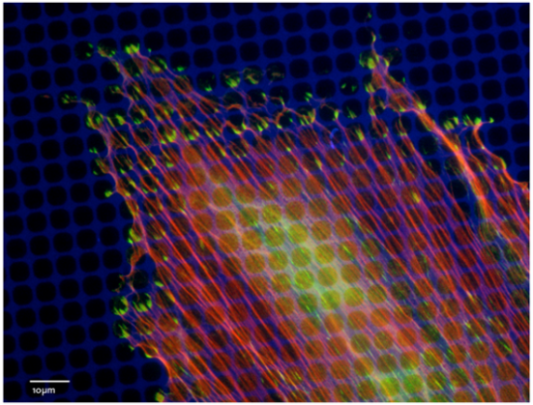Poly(L-lysine)-graft-poly(ethylene glycol)
SuSoS' PLL-g-PEG is a random graft co-polymer with a poly(L-lysine) backbone with poly(ethylene glycol) side-chains.
The PLL backbone interacts electrostatically with the substrate, while the side-chains extend from the surface and form a densely packed polymeric brush. The resulting coatings are non-fouling and provide a low level of non-specific binding of proteins and other macromolecules.
The use of PLL-g-PEG has been reported in hundreds of peer-reviewed publications and is currently in use in more than 40 research groups. Applications range from general non-fouling coatings to cell patterning, biosensing, microfluidics, particle and fiber modification to more specialized applications, such as the coating of AFM tips or implants.
Thanks to a simple dip-and-rinse coating protocol based on aqueous solutions, no high-end equipment is required to obtain highly reproducible and stable results in an environmentally friendly process.

Paxillin-GFP (green) expressing Ref 52 fibroblast grown on micropatterns of 5 x 5 µm adhesive fibronectin squares separated by 1 µm PLL-g-PEG-Atto633 (blue). The cell was fixed and stained for actin using phalloidin-TRITC (red). Images were taken at a Zeiss Life Cell Station using a 63x oil immersion objective with NA of 1.4. Courtesy of F. Anderegg, Laboratory for Surface Science and Technology, ETH Zurich, www.surface.mat.ethz.ch
Coating description: Poly(L-lysine)-graft-poly(ethylene glycol) monomolecular coatings
Substrate examples: Glass, quartz, silicon wafers, polyolefin (COC and COP), (plasma-activated) polymers, metal oxides (Ta2O5, ITO, TiO2, ZrO2)
Immobilization mechanism: Electrostatic adsorption
Availability:
- As surface active material in our Webshop
- Coated standard microscope slides - Please request offer here!
- Specific customer specific substrate - Conact our sales team for more information!
Key product features:
- Reduces adhesion of proteins, bacteria and cells onto surfaces
- Simple dip-and-rinse coating procedure suitable for various substrates
- Functionally equivalent, fluorescently tagged versions available (as standard products).
- Easy to pattern
Typical applications:
- Blocking of cell-adhesion
- Blocking of protein-non-specific signals in microscopy applications
- Non-reactive background for proteomics applications
- Non-reactive background for cell-culture applications
- Patterned biochips for controlled uptake of DNA/RNA strains, proteins, or cells
- Lubricating additive for water-based lubrication
The PLL-g-PEG technology is protected by international patents controlled by SuSoS. All rigths reserved.

